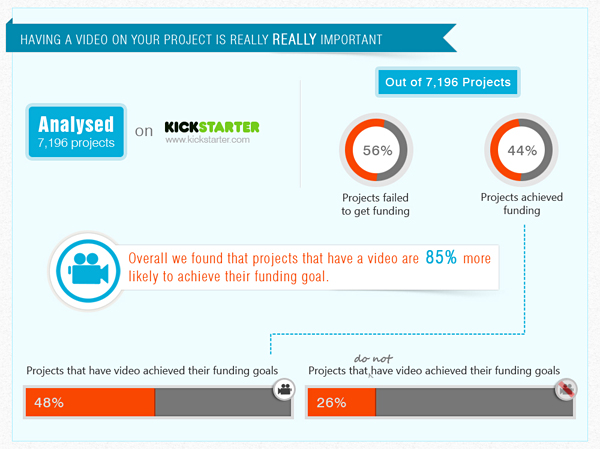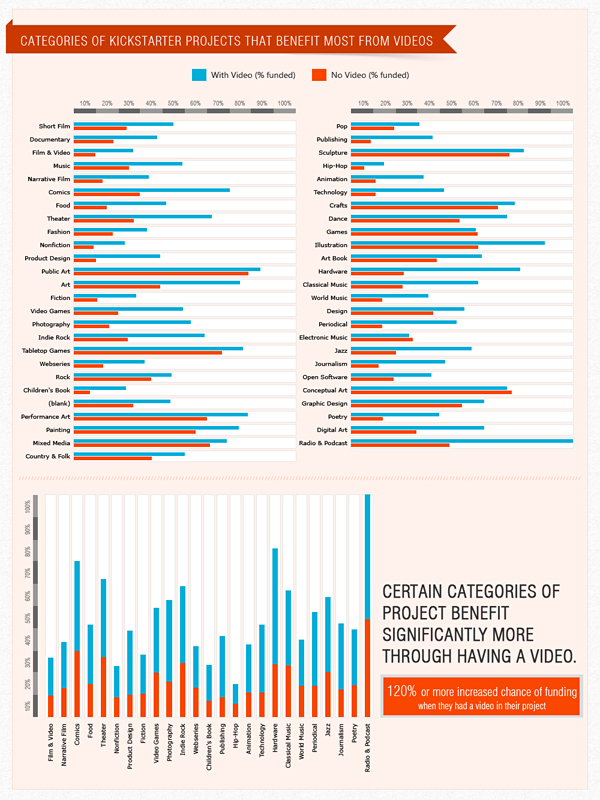It’s no secret. Your Kickstarter project video is the most important component of your campaign. It’s usually the first thing that backers see when they visit your page and it’s your one chance to have them coming away from your project feeling different.
Will they be ecstatic, raving, and share your project with all their friends, or will they click off after the first 30 seconds and see what their friends are up to on Facebook?
By Indiegogo’s estimates, projects with a video can raise 115% more than projects that do not have a video. According to Kickstarter, projects with videos succeed at a much higher rate than those without (50% vs. 30%).
In addition, MWPDigitaMmedia, who analyzed 7,196 Kickstarter projects in 2013, projects that have a video are 85% more likely to achieve their funding goal. Check out the stats they collected below.

Source: MWPDigitalMedia

Source: MWPDigitalMedia
Also, Professor Ethan Mollick of the University of Pennsylvania examined a Kickstarter data set comprised of 47,000 projects from May 3, 2009 to August 1, 2012 and concluded that an average film project (holding all else constant) with a video would have a 37% chance of success and only a 15% chance of success without a video.
You get the message. A video is crucial for your campaign’s success. We’ve already covered some Kickstarter video mistakes, so in this post we’ve distilled 10 tips practical tips you can implement for a winning crowdfunding video. Let me know if you find them to be helpful in the comments below.
1. Don’t re-invent the wheel.
 I think that research is the first step that you should take, whether it’s developing a marketing strategy or the storyboard layout of your video pitch.
I think that research is the first step that you should take, whether it’s developing a marketing strategy or the storyboard layout of your video pitch.
There are so many different types of categories on Kickstarter and individual niches that blanket advice is not always the best advice. Set aside an hour and create an excel spreadsheet of 10-20 campaigns in your category or projects that are going after a similar backer demographic as yours, and compare.
What elements did their videos focus on? Were there any major differences between the projects that were successful and those that did not meet their goal? What did you find engaging about the videos and when did you begin to tune-out?
In addition to taking note of the structural elements of the videos, I would also pay attention to the emotions that you feel as you watch the videos and what scenes made you feel those emotions. You can use those as a blueprint to invoking similar emotions for your backers.
2. Transitions and angles are your friend.
 If you’ve ever watched SharkTank, you know that pitching is tough! One thing you will notice if you watch that show is that the camera doesn’t focus solely on the entrepreneur or the product. Every 20-30 seconds minimum, there is a transition and frequently multiple camera angles.
If you’ve ever watched SharkTank, you know that pitching is tough! One thing you will notice if you watch that show is that the camera doesn’t focus solely on the entrepreneur or the product. Every 20-30 seconds minimum, there is a transition and frequently multiple camera angles.
This is because focusing the camera in the same position for a full 2-5 minutes is boring! By incorporating multiple camera angles or at the very least, transitions, you can maintain your backers’ attention and interest throughout the pitch.
If you don’t believe me, just take a look at popular YouTubers like Philip Defranco or Jenna Marbles. They use jump cuts and transitions throughout their video to maintain attention all the time.
3. Good lighting is a must.
This tip is ridiculously easy to incorporate and can make the difference between it looking like you just threw up a video hoping for pledges or actually put some thought into the production and pitch.
People respond to faces, both in terms of interest and when deciding who to trust. If your image is blurry or it’s difficult to see your face because of poor lighting, this interferes with your ability to form a relationship with potential backers.
4. Consider copyright law.
While the chances can seem slim, it’s important to be aware of other creator’s rights, one of which is the right to taking action against copyright infringement. Even if you attribute images/sound/video to the proper source, you can still get in trouble if you do not have the creator’s express permission.
We wrote a bit about this a bit in our post on navigating crowdfunding legal issues. There are plenty of websites that you can use to get royalty free stock video footage or free images that you can use under the creative commons or public domain license.
5. Does video duration matter?
If you’ve already started doing research in preparation for your Kickstarter, you’ll know that the sweet spot is 3-5 minutes for the pitch video. At the same time, I get people saying all the time, “Well this project had an 8 minute video and they were successful!”
 The key is that you don’t want the viewer to be bored at any time throughout your video or think to themselves “when is this going to be over?”
The key is that you don’t want the viewer to be bored at any time throughout your video or think to themselves “when is this going to be over?”
For most people, shorter is better, as it forces them to weed out extraneous information and focus on making those 3-5 minutes amazing. However, if you have a fanbase that you know will watch whatever length video you put up and the 8 minutes are extremely entertaining and make the viewer walk away thinking “That was awesome!” then go for it.
I know that 3 minutes sounds like a short duration, but in internet time, it’s super long. You can get a feel for the optimal time by revisiting point #1 – research. Look through several campaigns in your category and watch their videos. Do you begin to get bored at any point? When does your attention span wane?
When you finish your video, you should also show it to family, friends, and ideally a stranger or two to get their feedback on the duration.
6. Checklist of points you should consider.
Who – Who are you? Why are you credible? What is your background
What – What is the prototype or product? Show, tell, and paint a picture as to how someone would use it in their daily life.
Where – Where will this product be made and what regions can you ship it to?
When – When will the rewards ship out or when do you plan to complete the project?
Why – Why are you doing this project? Why are you passionate about it? Why is it needed?
How – How are you going to execute on your vision for the project?
I don’t think you need to hit all of these in the video, as you can explain them in the campaign text, but I think the most crucial aspects are what the project is, why you are doing it, who you are, and what rewards are available (if there are any unique ones).
7. The art of the thumbnail.
Youtube creators have mastered the art of the thumbnail. They figured out how to get rapid browsers between the ages of 18-34 to click on and watch their videos by using intriguing images that capture people’s attention.
On Kickstarter your video thumbnail not only shows up on any websites that embed your video pitch, but also in the Kickstarter discovery engine. Use this functionality as another way to engage with potential backers.
Don’t be afraid to use photo editing software like Pixlr (free) or Photoshop to combine multiple images or to overlay your logo onto a product picture.
You can also change your thumbnail throughout the duration of your campaign to announce key milestones.
8. What is your call to action?
Call to actions get a bad rep from gimmicky marketers using phrases like “Don’t wait to buy now!” and “Limited time offer, get it while it’s hot!”
The true underlying purpose of a call to action is to focus someone’s attention on what action they should take now that they have watched your video, visited your website, or read your blog post.
If you are speaking to a particular audience, think about what items about your project that they will resonate with. Should they support the project to bring back a previous game series you made? Are they pledging their hard-earned dollars because getting your product out there will change the world?
Ultimately, your call to action should connect the problem that the potential backer is experiencing or cares about with your solution and how they can make it possible.
9. Consider hiring a professional.
If you have the budget and don’t want to take the time to create and edit the video yourself, you could consider hiring a professional. There are a few different services providers that I know of that offer video editing/creation services for Kickstarter campaigns. Recently, I did a video interview with Leigh Lepore who runs CrowdfundingStrategy. She offers Kickstarter video services that I would recommend.
If you don’t have the budget, there alternatives! In our interview with TagTalk, we talked about how the founders employed local university film students to help create the video. It was a great learning experience for the students and an inexpensive way to make the video.
“We emailed local universities that carry film programs. Usually the departments are proactive about getting students some hand-ons experience, so they broadcasted about the task and helped us to schedule two meetings in a very short timeframe. We met an avid film practitioner the very next day who had access to all the filming equipment needed, loved our idea, and who lives just down the street!” – Read more.
10. Commercial vs. Apple commercial?
Although there have been some successful Kickstarter projects that have commercial-type videos, I think they are the minority. Your project video should not be a commercial for a product.
If you are set on a commercial-type video and really want an example as to the type of commercial you should be aiming for, the best example that I can think of in the business world is the way that Apple creates videos about their latest products, describing the effort that went into making the and what the mission was behind the project. It’s clear they deeply care about their products and have put a lot of thought into the design.
I’ve included the youtube video for the original macbook unibody below (2008).
At the end of the day, the video must be a narrative. I think Rob Balder who raised $130,688 on Kickstarter said it best:
“Narrative is the story you tell about who you are and what you want to do. You have to convince potential donors of several things. First, that you are a person worth supporting. Second, that this idea is worth making real. And finally, that you are a person who is capable of coming through and actually making it come true.” – Read more here.
Conclusion
What challenges did you run into when making your Kickstarter video? I’d love to hear in the comments section below!




